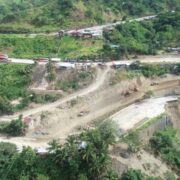Phivolcs warns of another blast as Kanlaon shows signs of unrest

BACOLOD CITY-Mt. Kanlaon, which erupted on June 3 and displaced thousands of residents in surrounding localities in Negros Occidental and Negros Oriental, is again showing signs of restiveness that may lead to “explosive eruptions,” state volcanologists said.
The Philippine Institute of Volcanology and Seismology (Phivolcs) has warned that Mt. Kanlaon recorded the highest emission of volcanic gas since instrumental gas monitoring began on Friday, June 28.
Volcanic sulfur dioxide (SO2) gas emission from the summit crater of Mt. Kanlaon based on campaign Flyspec measurements averaged 5.397 tons on Friday, according to Phivolcs.
“This means that there is current unrest driven by shallow magmatic processes that could eventually lead to explosive eruptions or even precede hazardous magmatic eruption at the summit crater,” Phivolcs said in an advisory.
Mt. Kanlaon, which is now under alert level 2, has been degassing increased concentrations of volcanic SO2 this year at an average rate of 1,897 tons per day, but emission since its June 3 eruption has been particularly elevated at an average of 3.175 tons per day, Phivolcs said.
The volcanic earthquakes at Mt. Kanlaon has persisted at an average of 10 events per day since its eruption, it added.
Inflation rate
Ground deformation data from continuous global positioning systems and electronic tilt measurements have been recording medium-term inflation of the Mt. Kanlaon edifice since March 2022, and a shorter-term inflation of the eastern flank since 2023, indicating slow but sustained pressure buildup within the volcano.
The magmatic processes beneath the volcano may be driving current unrest, causing persistently high concentrations of volcanic gas emission, swelling of the edifice and occasional volcanic earthquake activity, Phivolcs said.
Phivolcs reminded the public to be vigilant and avoid entry into Mt. Kanlaon’s 4-kilometer radius Permanent Danger Zone (PDZ) to minimize risks from volcanic hazards such as pyroclastic density currents, ballistic projectiles, rockfall and others.
Phivolcs said that in case of ash falling from the volcano, people should cover their nose and mouth with a damp, clean cloth or dust mask.
Civil aviation authorities and pilots were also reminded to avoid flying close to the volcano’s summit as ash and ballistic fragments from sudden eruption can be hazardous to aircraft.
Displaced families
Communities living beside river systems on the southern and western slopes, especially those that have already experienced lahars and muddy streamflows, were also urged to take precautionary measures when heavy rainfall over the volcano has been forecast or has begun.
Mt. Kanlaon’s June 3 explosion affected some 15,815 families or 50,977 persons in 23 villages in Negros Occidental and Negros Oriental, according to a Department of Social Welfare and Development report on June 25.
The affected families were from the town of La Castellana and the cities La Carlota and Bago in Negros Occidental and Canlaon City in Negros Oriental.
In La Castellana, the eruption forced 4,000 residents to evacuate but most of them have been allowed to return to their respective homes last week. Only 39 families with 116 members remained in one evacuation center, as they are residents of PDZ in sections of the villages of Biak na Bato and Masulog.
Damage to crops and fisheries in Negros Occidental due to the volcano’s eruption reached P84.1 million.

















